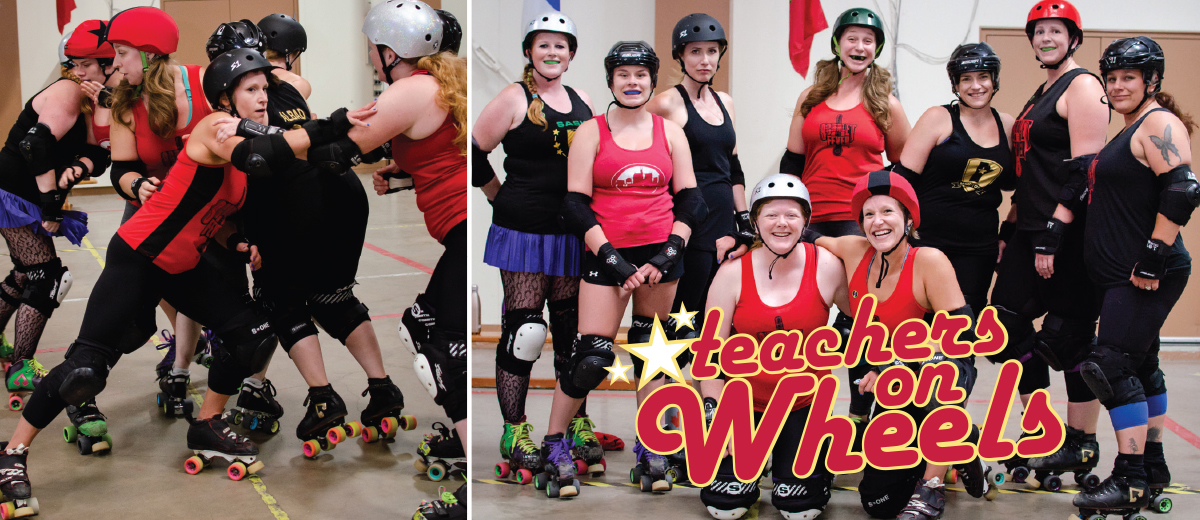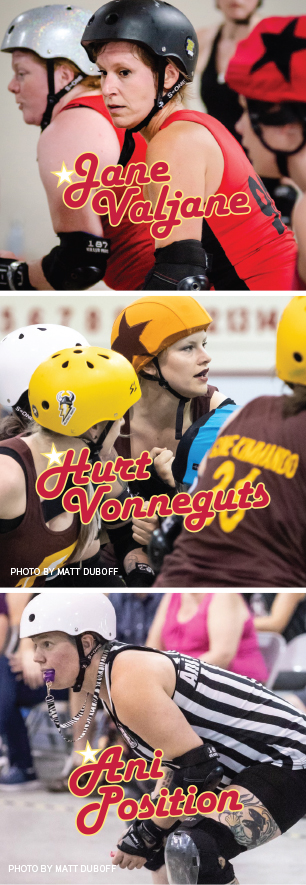
Story and photos by Matea Tuhtar (Feature Photo by Matt Duboff)
To play a notoriously rough and tough, high-intensity, full contact sport like Roller Derby, you have to be passionate, confident and not give up when the going gets tough. Luckily, as three Manitoba educators can attest, teaching demands the same skills.
Sarah Jane Maynard, Catherine Hart, and Tannys Moffatt are teachers by day and Derby Girls by night. They train in arenas around the province, skating aggressively around a flat track, blocking, jamming, striking, falling, getting hit, and then picking themselves up again.
“It takes grit, much like teaching, especially at the beginning!” says Maynard – aka Jane Valjane – who teaches French immersion at École Harrison in Brandon and plays for the Wheat City Rollers.
Maynard discovered roller derby purely by chance, but…“roller derby could not have chosen a better moment to find me!”
She moved to Brandon from Yarmouth, Nova Scotia in May of 2013 and began her life as a new Manitoba teacher.
“In my first year I made a rookie mistake of spending the majority of my free time deeply focussed on school work – assessing everything, building lessons from scratch, and then falling into bed unsure I’d done enough preparation to fill the next day with engaging lessons and activities.”
Her new lifestyle left little time for exercise or self-care but after surviving her first year, she discovered that… “The best classroom ideas came when the classroom was furthest from my mind!” One night while at a rock concert fundraiser she spotted a diverse group of women, which she later discovered were a local roller derby team.
“There was such an aura of excitement and camaraderie about these women in matching jerseys that I was moved to inquire.” The rest, as they say, is history.
The sport began its roots in the 1930s, with many incarnations over the years including the flashy, rebellious, violent spectacle that captured people’s attention in the ‘80s and ‘90s. The modern version of derby was reinvented and built by women for women, focusing on sporting integrity and rules and regulations, while still carrying its main theme of feminism and empowerment. Unlike most other women’s sports that need a qualifier – such as women’s soccer, or women’s basketball, roller derby by itself is uniquely female. Men’s leagues exist but they play ‘men’s roller derby’.
 Roller derby has been spreading throughout the world since the early 2000s with the Winnipeg league established in 2008. Tannys Moffatt – aka Ani Position – is a science teacher at Tec Voc High School in Winnipeg, and a long time roller derby skater– one of the first, in fact. Today she is an “A” level player for the Winnipeg All-Stars as well as an officiant and head trainer for new skaters. She has travelled all over with the All Stars including Philadelphia, Minneapolis, Denver, Fort Lauderdale and Waterloo.
Roller derby has been spreading throughout the world since the early 2000s with the Winnipeg league established in 2008. Tannys Moffatt – aka Ani Position – is a science teacher at Tec Voc High School in Winnipeg, and a long time roller derby skater– one of the first, in fact. Today she is an “A” level player for the Winnipeg All-Stars as well as an officiant and head trainer for new skaters. She has travelled all over with the All Stars including Philadelphia, Minneapolis, Denver, Fort Lauderdale and Waterloo.
“I remember our first game in Fargo – it was our first game and it was their first game, and I cringe when I watch that footage now. A lot has changed over the years!”
A roller derby game is called a ‘bout’. Teams have five players, a ‘jammer’ who is responsible for scoring points, and four blockers whose job is to prevent the jammer from passing through. Today the international governing body is the WFTDA (Women’s Flat Track Derby Association) and “It’s growing as more and more of a mainstream sport,” says Hart. “There’s a World Cup with international teams, as well as Roller Con – a huge skating convention that happens in Vegas every year. “
Hart – aka Hurt Vonneguts is a newer player in the Winnipeg Derby League, as well as a teacher in Winnipeg and a member of the MTS Provincial Executive. She says people are often surprised to hear she plays roller derby because she can come across as more quiet and reserved.
“They often ask things like “Isn’t that a really aggressive sport?” and “Is it like the movie Whip It?” (Whip It is a popular 2009 Hollywood movie about the world of roller derby).
Hart’s derby name is a play on her role as an English teacher. “It’s funny, sometimes we only know each other by our derby names,” she laughs. “It’s fun to have that alter ego.”
Teams often have different themes with theatrical costumes for the players, though these days those are mostly used for photos and promotions. Otherwise, players wear their uniforms for the game, which is an intense workout. Players usually practice for two hours twice a week, in addition to helping run their league.
Hart says playing is like doing squats constantly.
“You really build up your muscles, and you really want to cross-train and make sure you’re doing a lot of core exercises. I think it’s good for your mental health as well. I think when you have a lot of mental stress but you’re not tiring yourself out physically then it’s the wrong kind of tired.”
While the game is aggressive, it’s not as dangerous as it looks. “You’re taught everything – how to stop and how to fall down because you’ll be doing it a lot,” says Maynard. “It can be scary at first but your gear is there to catch you.”
Still, the hands on learning is tough.
“I lived the learning mottos found on classroom posters – I fell and got back up – often. I took risks. I learned from mistakes. I practiced, practiced and practiced. And I asked for help.”
In derby, skaters teach other skaters through a program called Fresh Meat. People come in with all stages of fitness but to be able to play they have to meet a list of skills and pass an endurance test where they have to skate around the track 27 times in 5 minutes. The women come from all walks of life as well. Maynard’s team is made up of a military veteran, hair stylist, insurance broker, pharmacist and biologist, but despite their different backgrounds the teams are all about empowering women.
“It’s sisterhood a hundred percent. It is about diversity and lifting each other up and accepting our bodies in different ways. And it’s about being able to be tough and aggressive – so often we’re taught that we’re not allowed, but when you start it’s so liberating.”
Hart agrees. “It’s a very supportive culture, they stress camaraderie. It’s an overtly feminine sport and very empowering. ‘Not sorry’ is kind of the mantra, don’t be sorry for being aggressive or taking up space.”
Moffatt says some of her students know about her skating, and some have been interested in joining, while Maynard has already had three students join a junior derby team in Brandon. “We are trying to get more youth involved. Our numbers have been pretty constant the last few years.”
All three skaters say their favorite things about Roller Derby is the sense of community that comes with being part of a team. The sport is famously inclusive, even in the youth league, which accepts transgendered kids.
“Diversity is crucial to a successful roller derby team,” says Maynard. “Differing sizes, shapes, strengths, and mentalities work together to achieve a common goal. A school or classroom works in the same way – they succeed to their fullest potential when everyone is able to play to their strengths and work and learn as a team.”
“Made up of small wins and losses, the game is at once challenging, unpredictable and exhilarating. This might be a stretch but – is it so different from a day at school?”
Anyone who is interested in learning more about Roller Derby can check out the Winnipeg Roller Derby Instagram and Facebook page, or go to www.winnipegrollerderby.com (Winnipeg), www.wheatcityrollerderby.com (Brandon), or www.plapcityrollers.com (Portage la Prairie).
— This story was originally printed in the October/November 2018 issue of The Manitoba Teacher Magazine
